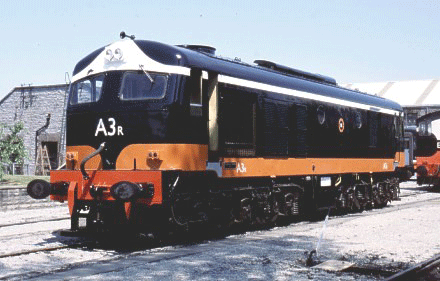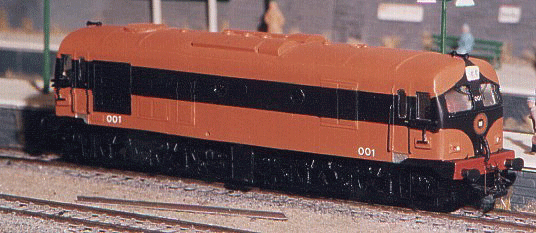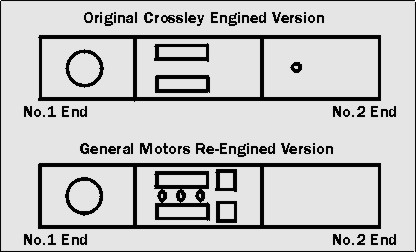Steve Johnson Modelmaker
|
|
Metropolitan-Vickers A Class The Prototype
CIÉ ordered 60 of these main line locomotives in 1955. Built by Metropolitan Vickers, these Co-Co diesel-electric's were fitted with the Crossley HST Vee 8 2 stroke engine developing 1,200bhp. The electrical equipment was supplied by Metropolitan Vickers. They weighed in at 82 tons and had a maximum speed of 75mph. The Crossley engine was notoriously unreliable and by the late 1960's the availability of these locomotives had become critical, necessitating a radical rebuilding programme. This was carried out in 1970 and involved replacing the Crossley engine with a General Motors 12-645E two stroke V12 of 1,325bhp and rewinding the main generator. To distinguish re-engined locomotives, the suffix 'r' was placed after the locomotive number. In 1974, the class was redesignated 001 Class, were renumbered 001 to 060 and carried the revised Golden Brown/Black livery. They continued in this form with minor modifications along the way until 1998. Two are now preserved by the Irish Traction Group. The Model
Two versions of this model have been available, one by MTK and one by Q Kits. The MTK version was a combination of etched brass and white metal and left a little to be desired in its appearance. The only currently available model of an A Class is a white metal kit supplied by Q Kits. It comes as two cab ends, three roof panels and four bodyside panels. Included in the kit are various etchings for the radiator frost guard and roof mounted grille. The castings are generally of poor quality and a good deal of filling and filing are necessary to make an acceptable bodyshell. Both the original and re-engined versions may be built from the kit. The original versions did not have the headlights, so these would have to be filed off. Also the roof detail is slightly different. As supplied, there are three exhaust vents either side of the roof cowlings and one other towards the No.2 end cab. If you are modelling the original version, the group of three vents have to be filed off and the original vent retained. The later re-engined version requires the removal of the single vent and the separate roof cowling castings fitted.
The token catchers fitted below each cab window are best acquired from MIR. More discreet air horns are advisable and the turned brass items from A1 Railmatch suffice. Correct shade paint is from MIR with the Roundal transfers coming from Mabex. The bodyside numbers are actually white with a black drop shadow. I achieved this effect by first applying black Letraset or Edding dry transfers and then placing the white numbers of the same typeface slightly above and to the left. The chassis is a shortened Airfix Class 31. This has similar Commonwealth bogies to the A Class and a five pole motor. Glazing was achieved by my own method of flush glazing with the bodyside portholes using Humbrol Clear Fix. My model has now been converted to 21mm P4 in the following manner. You will need 10 Alan Gibson 3'2" (12.6mm) diesel wheels (part number G4838D) and a length of 1/8" silver steel rod, from Eileen's Emporium for instance. The Airfix chassis uses 1/8" axles and it is simply a case of making new longer axles from the silver steel rod, placing the original Airfix gear on the driven axles and fitting the new P4 profile wheels. The inside of the bogie sideframes will need taking back a little to clear the wheels with a file or similar. The only trouble with the Airfix motor bogie is the dummy centre wheel. I am still working on this. An alternative is to use a cut down Athearn Chassis. Sprung oval buffers can be fitted and new coupling's, such as the Alex Jackson type, will finish off the model. Handrails are made from 0.33mm brass wire and either Craftsman or A1 models etched brass windscreen wipers can be used. I like to fit cab interior detail where possible and have done so in the A Class. This is simply done by adding a bulkhead and false floor. On the floor I have added two seats on pedestals (cut down carriage seating with plastic tube as pedestals) and the rather obvious handbrake (Craftsman tender brake column, part no.54) situated between the two seats. The general cab interior colour is cream with the seats in maroon and the handbrake in red. Lamp irons were made out of some narrow scrap brass from an etched fret and fitted on the buffer beam. Silver Fox A Class Silver Fox Models currently produce a resin bodied A Class that is available either as a kit or a ready to run model in a variety of liveries. Although I have a body, I have not got around to building it. |


